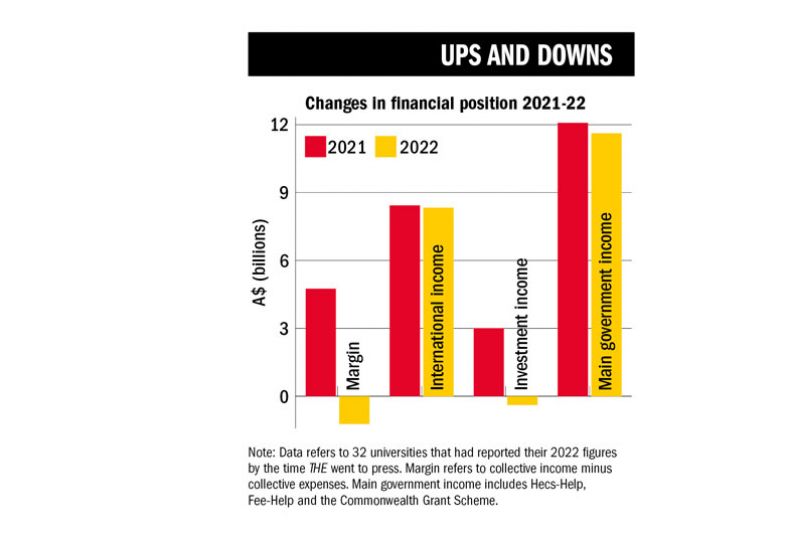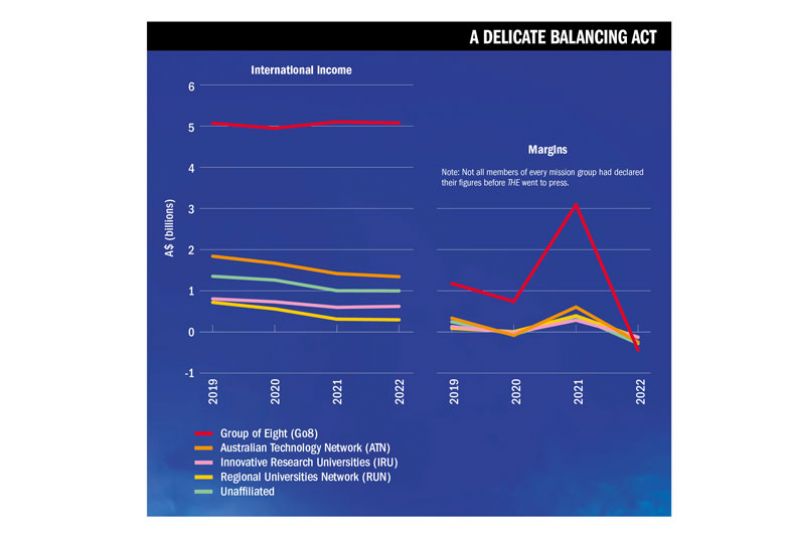When the then Universities Australia (UA) chair John Dewar appeared before Canberra’s National Press Club in July 2022, the word on every journalist’s lips was “surpluses”. Why had the sector Dewar represented found it necessary to retrench so many staff in year one of the Covid-19 pandemic, only to report record surpluses in year two?
In both cases, the numbers were jaw-dropping. Nobody knows just how many Australian university workers lost their jobs in 2020, but a UA survey produced an estimate of 17,300. This figure – a combination of permanent employees, casuals and fixed-term staff who were not rehired because of Covid impacts – was about six times as high as the retrenchment tally in the UK, according to an early calculation. And it was likely an underestimate, with a University of Melbourne analysis finding that up to 36,000 casual jobs had disappeared across Australia.
University surpluses are easier to quantify because of the prescriptive financial disclosures required by legislation. The sector earned A$5.4 billion (£2.9 billion) more than it spent in 2021, as margins that would have been outliers any other year became commonplace. While the standout was the University of Sydney’s surplus of A$1.05 billion – roughly triple the previous record for a single institution – the other Group of Eight (Go8) member institutions also pocketed excess funds of hundreds of millions of dollars each. Just three universities across the country finished the year in the red – a remarkable turnaround from the 14 deficits recorded in 2020.
While the Go8 had monopolised an extra billion dollars of research funding granted as a Covid relief measure, the stock market was the main contributor to the surpluses, with most institutions reaping seven- or eight-digit windfalls from investments and the sale of a holding company for their shares in education business IDP. Legislation requires universities to include such “one-offs” in their net financial results, Dewar explained during the press conference.
But Australian universities had good reason to be prudent, added Dewar, who is vice-chancellor of Melbourne’s La Trobe University. “This is the worst year for all of us,” he said. “We’ve got fewer international students in Australia than we’ve had since the start of the pandemic, and we could see that coming. A lot of vice-chancellors [are] forecasting that they will be reporting deficits. That’s what people foresaw. [They] took action to…prepare themselves for what they knew was going to be a very tough 2022 and, potentially, a very tough 2023. In doing so, they may have generated more surplus revenue over cost.”

Monash University vice-chancellor Margaret Gardner offered much the same message during a webinar organised by the Melbourne Centre for the Study of Higher Education several weeks later. A “bumper year for investments” and the one-off research funding boost had “put a huge amount” into the research-intensive universities’ coffers “for a short period of time”.
But the “unrealised investment returns” would recede just as universities suffered “the full impact of reduced international student commencements”, Gardner warned. “People don’t seem to be able to see the cycle by which revenue comes into a university and then flows out. If you choke off [new enrolments] for a couple of years, you don’t see it the first year. You don’t see it the second year. Year three [is] the lowest point. This year is the lowest year ever for everybody’s international student revenue.”

As Dewar and Gardner had predicted, 2022 did indeed turn out to be a very bad year. Of the 32 Australian universities that published their 2022 financial accounts by this article’s publication deadline, 26 reported deficits. Their collective A$4.8 billion surplus in 2021 collapsed into a A$1.2 billion shortfall in 2022. But that reversal was mainly because of a A$3.4 billion drop in investment earnings. Earnings from overseas students declined by just 1.2 per cent, or A$100 million, compared with 2021. And of the 32 universities, 12 even managed to increase their revenue from this source, some by tens of millions of dollars. The so-called pipeline effect – the idea that losses on international education would be worst in the pandemic’s out years – had simply not eventuated.
To be fair to Dewar and Gardner, their institutions fared worse than most, with international education earnings falling a further 8 per cent in 2022 at La Trobe and 7 per cent at Monash. But both declines were dwarfed by the previous year’s losses, suggesting that at these two institutions – and many others, although certainly not all – international education has already bottomed out.
“The back half of last year was better than we expected,” Dewar now concedes. When he addressed the Press Club in July, student arrival data were only available from early in the year “and they didn’t look good. Things picked up significantly in the second half of last year so that the decline in international student revenue wasn’t as bad as we feared. Once all of the restrictions were lifted and people could start getting flights into the country, the numbers and revenue started coming back.”
Back in 2020, in the early days of the pandemic, universities’ fierce guarding of their cash stocks was understandable since they simply did not know what was coming, according to policy expert Andrew Norton. The government’s “fairly generous” rescue package was not announced until October of that year, when retrenchment decisions had already been made. In addition, universities “didn’t realise until late 2020 or early 2021 that the Chinese market was much stronger than anyone would have realistically thought”, says Norton, who is professor in the practice of higher education policy at the Australian National University.
The pain of 2020 prompted much introspection about a higher education business model so heavily reliant on a revenue stream as potentially uncertain as international education. But Norton says there is little sign of universities weaning themselves off this income source – partly because they have no obvious alternative.
“Sure, this is an up-and-down industry,” he observes. “But for some institutions, the ups are so far up that, totally understandably, they want to grab the large sums of money that are on the table. From their point of view, even if it doesn’t last, it’s good while it does.”
Higher education consultant Justin Bokor, a former commercial director at Monash University, says reducing international revenue would only work if the federal government offered compensatory funding – an “absolutely fanciful” notion in Australia’s current budgetary and political climate. Vice-chancellors need to be commercially minded, Bokor points out: “If you’re a business and you’ve got a product that’s in high demand, will grow for the next 20 years and is core to your finances, why would you walk away from that?”
Adding to the disincentives to walk away is the fact that domestic students’ appetite for study appears to be more brittle than that of their international classmates. Across the 32 institutions that have published their 2022 accounts to date, receipts from the three major income streams for domestic study – Hecs-Help (student loans for government-supported undergraduates), Fee-Help (student loans for non-supported students, typically postgraduates) and the Commonwealth Grant Scheme (teaching subsidies for government-supported students) – fell last year by 4 per cent, or A$465 million, almost five times the loss from international education.
While investment earnings – and losses – have driven recent university surpluses and deficits, Bokor says these flash-in-a-pan figures are not the main concern for universities’ chief financial officers. “What’s keeping them awake at night is how to regrow the domestic market,” he says. “They’re trying to rebuild international [earnings] but…they have to because of the decline in the domestic market.”

Some universities have the equivalent of 1,000 fewer full-time domestic students than they anticipated, Bokor says. “At a weighted average of A$20,000 per student, that’s [a budgetary hole of] A$20 million dollars. If you’re a A$700 million university, that’s 3 per cent [of your budget]. And if your target surplus is 6 per cent, there’s 3 per cent gone in the domestic market – and international is still bottoming out.”
Dewar says local students are “under-loading” on higher education as opportunities for paid employment soar. “They just enrol in fewer subjects. They’ve effectively turned themselves into part-time students because there are lots of job opportunities out there,” he says. “If there’s a rise in unemployment, I’m sure they’ll start coming back to fuller loads. These things can change quite quickly. But I know that last year, and to some extent this year, a lot of universities are experiencing quite a soft domestic demand – which is why the return of international students is important.”
And that situation illustrates that even domestic enrolment is not immune from the uncertainty that surrounds international recruitment, Dewar says: “There’s a bit more stability there because of government funding arrangements associated with those students. But if the students don’t show up, you [still] don’t get paid, basically.”
Monash’s Gardner adds that government funding for domestic student education has not been indexed to match inflation during the past decade, while the proportion of “secure” research funding of three to five years’ duration has also been decreasing. “In the current environment, income needs to be rising at between 4 and 7 per cent per annum to stand still,” Gardner notes. But Australia can no longer expect domestic enrolments to grow at the rate of recent decades, while competition for international students is only getting fiercer.
Universities’ reaction to precarious revenue streams has been to casualise their labour force, Norton says. “The employment model that universities have defaulted into served them very well over the last few years,” he explains. “It stopped any of them from going broke because they could reduce their costs reasonably quickly” by shedding staff.
While the National Tertiary Education Union rails against casualisation – and universities increasingly accept that it is not “sustainable” – Norton does not see it changing while the cost of retrenching permanent academics remains high. “A few hundred” casual staff are being offered permanent contracts under newly negotiated enterprise agreements, he concedes, but this is “a drop in the ocean”.
But is it acceptable for the risks to the sector’s revenue model to be borne primarily by the staff with the least secure employment and, usually, the worst progression opportunities?
“There are plenty of people for whom casual employment works really well,” says Ant Bagshaw, senior adviser with LEK Consulting. “But there are also lots of people for whom it doesn’t, and they’re bearing significant personal risk in terms of continued employment. We’ve seen extremely healthy demand for Australian higher education, and that’s a wonderful thing. We also see healthy demand for staff wanting to work in universities. Clearly, we should not take advantage of either of those groups to individual detriment.”
But how can universities accept the risk of funding secure employment for all their staff when the demand for their courses from domestic and, particularly, foreign students is so brittle? One answer, Bagshaw says, is to use some of the proceeds of international education to “self-insure” against possible future downturns in that revenue stream – effectively, by setting money aside in a “rainy day fund” to cover retrenchments should they be financially imperative.
That may not be as difficult as it sounds, he says, because it only requires a one-off investment that might be a fraction of total international earnings. “Once you have the next year’s enrolments, the liability window has passed, so you only have to keep a year’s cash aside," he says. "It might be a lot of money. It might be A$100 million. But next year, it’s still A$100 million. This way, while there’s still risk, it doesn’t all fall on the casual employee. It would enable more casuals to have ongoing employment.”
Bagshaw concedes that some sector insiders would see such a large contingency fund as unnecessary and argue that “actually, the risk is so low that you just bear it as it comes. But I think many people would be more comfortable with the confidence of a cash balance to pay out, if needed. If you sink the money into a building, you can’t release it unless you borrow against the building, which means extra cost and delay.”
Other contingency mechanisms might include a mutual savings club, into which all Australian universities paid according to their share of international enrolments. Or universities could seek commercial insurance – a strategy adopted in 2018 by US institution the University of Illinois at Urbana-Champaign, when it forked out over $424,000 (£335,000) to indemnify itself against a collapse in revenue from Chinese students. Or the federal government could mandate an assurance scheme to cover large-scale retrenchment costs, modelled perhaps on its Tuition Protection Service for students affected by college closures.
But why didn’t universities institute any of this during the pre-Covid boom in international enrolments? Part of it was deliberate strategy, according to Bokor: large posted surpluses could have been used by the federal government as a pretext to reduce higher education funding. But financial incontinence also played its part. “It’s easy to spend money,” Bokor says. “You get greater glory out of new buildings and it’s more fun than building up your reserves.”
In his view, the overall volatility of Australia’s international education trade is overstated: “If you look over the last 30 years, it’s a consistently high-growth market.” But it is exposed to “shocks”, such as the street violence that affected Indian enrolments in 2010. And since more shocks are inevitable, “we should be more careful about our cost base and try to reduce our exposure to the riskiest markets,” Bokor says.
Tertiary education consultant Claire Field says that universities’ attempts to reanimate their 2019 international recruitment pathways are understandable. “If you’re trying to rebuild after something as significant as a pandemic, you go back to markets where you are known and have strong relationships,” she says. But the sector is likely to face pressure to diversify into new source countries and new educational models, from both the Australian Universities Accord – the Labor government’s landmark higher education review, due to report imminently – and the inquiry into international education by the national parliament’s Joint Standing Committee on Foreign Affairs, Defence and Trade.
The current Australian Strategy for International Education also has a heavy emphasis on diversification, committing the government to “drive transparency” in institutional performance through “an easy-to-understand measure”, including a “diversification index”.
Some universities are actively recruiting in “new international education channels”, says Zac Ashkanasy, head of higher education with the Nous Group management consultancy. But prospective students in those markets are “more price-sensitive”, he warns. “There are online opportunities that didn’t previously exist. Whether it’s direct offshore online delivery or more novel online pathways to an Australian institution, those represent new models to create a more resilient international student pipeline.” The problem is that “the margins for those new channels are lower. You might still be able to get the volume of students. But you may not be able to get the level of financial margin, which just adds to the pressure on universities.”
Field says institution-level data already exists on the proportion of international students universities recruit from each country; publishing such data would encourage institutions to have “a balanced international student cohort”, she believes, improving the enrolment mix for locals and foreigners alike. But entering new markets is costly and time-consuming, she warns. And if the government intends to force universities into actions that reduce their international education earnings, it should compensate them with “better research funding”, she suggests.
Australia’s heavy reliance on foreign students’ tuition fees to bankroll university research dominated discussion at this year’s Times Higher Education Campus Live ANZ event at the University of Queensland. For instance, Queensland University of Technology vice-chancellor Margaret Sheil told the June event that “the main funder of our research effort over the last 15 years…has been the cross-subsidy from international fee revenue”. Sheil, a former chief executive of the Australian Research Council, added that Australia needed to move to a “rational system” in which the full costs of research – both direct project expenses and overheads – were covered by research funding agencies.
University of Queensland vice-chancellor Deborah Terry said full funding of research would be “nirvana”. As a first step, money to pay for overheads needed to be raised towards 50 cents for every dollar granted by the main funding agencies: “It’s 19 cents in the dollar now, and that is not sufficient. Increasing that…would be a very significant step forward.”
Griffith University vice-chancellor Carolyn Evans described research funding as the “existential crisis” facing Australian higher education and told the conference that she hoped the Universities Accord will finally get to grips with the issue. If it doesn’t “the next 20 years will be grim”, she said. Universities would have no choice but to keep growing – largely by further increasing the number and proportion of international students they recruit – to keep their research operations “sustainable”.
But University of Sydney sociologist Salvatore Babones, who critiqued Australian universities’ approach to international education in a 2021 book, Australia’s Universities: Can They Reform?, is scathing of such arguments. In his view, “the narrative…that international student revenue is necessary to make up for a shortfall in commonwealth funding is…just not true.” However, he adds, it sounds credible and is exploited by university administrators to justify their ever-expanding resort to international education’s “endless pot of gold” to pay the salaries of researchers who “generate publications so the universities can rise in the rankings”. He describes such institutional behaviour as “pathological. It’s a warp of public-sector priorities.”
Norton is more sympathetic, saying that universities’ “diversified” revenue streams helped them survive the pandemic much more successfully than sectors such as tourism or retail. But he agrees with Babones that universities have a “completely insatiable” appetite for research funding: “My view is that whatever extra money the commonwealth gives [universities] for research will not change the international student market at all. No matter how much you give them, they’ll spend it all and they will be back asking for more.”
Many in the sector regard more research as a good thing, of course. The Go8 hails the role of research in strengthening civil society, underpinning national well-being and generating solutions to global challenges – not least, Covid-19 itself. Go8 chief executive Vicki Thomson says the pandemic has helped shine a spotlight on the scale of cross-subsidisation of research, and the Universities Accord provides an opportunity to “have an honest discussion” about how research is funded, who should fund it and how the money should be distributed.
“We need to sort out research funding as a system and not fight over the same diminishing pie,” she says. “The [education] minister has said that he wants major reform in the sector. This is the opportunity to do that. That is why there is so much hope resting on what comes out of the accord.”
Register to continue
Why register?
- Registration is free and only takes a moment
- Once registered, you can read 3 articles a month
- Sign up for our newsletter
Subscribe
Or subscribe for unlimited access to:
- Unlimited access to news, views, insights & reviews
- Digital editions
- Digital access to THE’s university and college rankings analysis
Already registered or a current subscriber? Login








